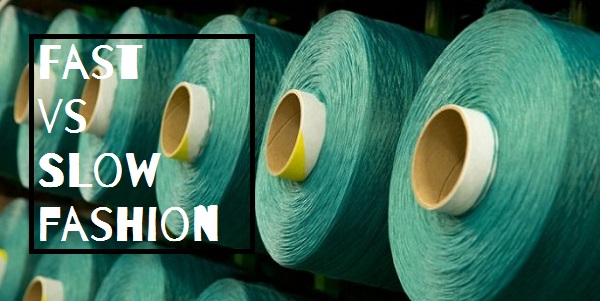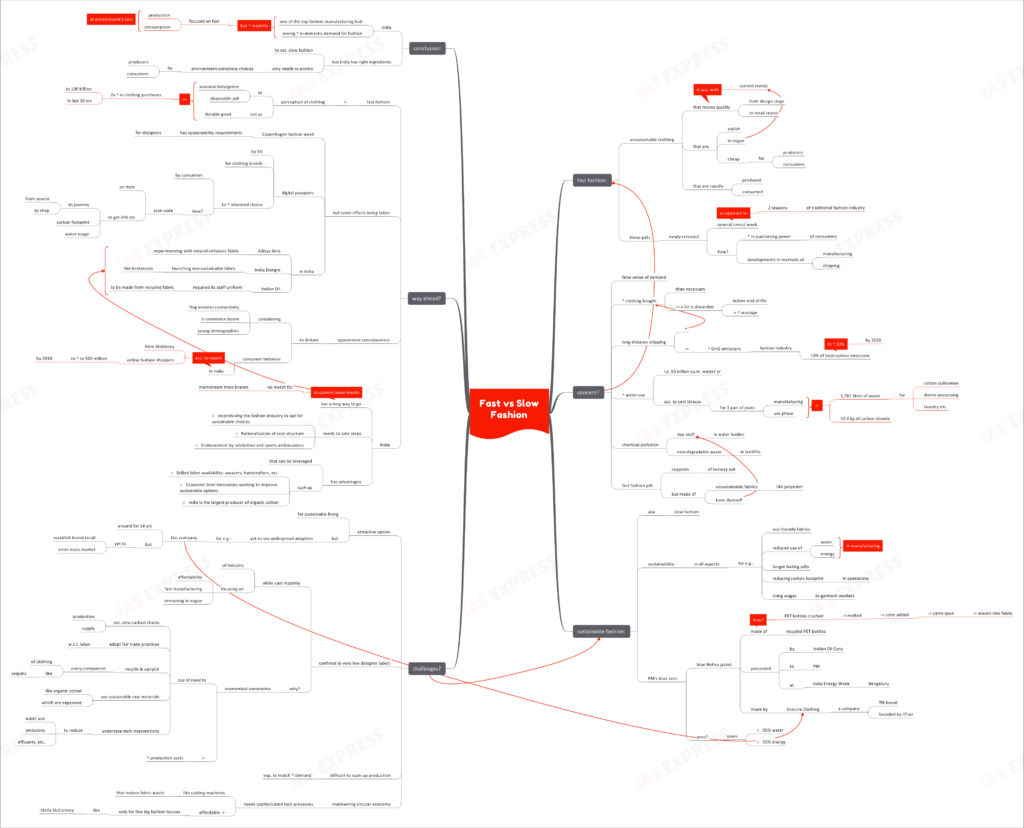Fast vs Slow Fashion- in Pursuit of Sustainable Clothing

Recently, the Prime Minister was spotted wearing a blue vest manufactured from recycled plastic bottles. This brings the focus on the importance of adopting sustainable clothing in our pursuit of sustainable living.

What is fast fashion?
- Fast fashion refers to unsustainable clothing that move quickly from design stage to the retail stores, in accordance with the current trends. It refers to fashion products that are ‘rapidly produced and consumed’.
- While these clothing are stylish and ‘in vogue’, they are also cheap to produce and affordable for the consumers.
- The increase in consumers’ purchasing power and the developments in manufacturing and shipping methods have enabled some retailers to launch new clothing lines multiple times in a single week. In comparison, the fashion industry traditionally has only 2 ‘seasons’ in a year when new clothing lines are introduced.
Why is it a concern?
- Given how quickly the trend changes, consumers tend to purchase fast fashion products to keep up. This results in a false sense of demand.
- This also means that the consumer ends up with more clothing than is useful. Hence, a significant portion of the clothing is discarded before the end of its life. This creates a lot of waste.
- Since, these products are shipped long distances to reach the target consumers, such increased consumption translates into massive greenhouse gas emissions.
- The fashion industry accounts for 10% of the total carbon emissions.
- This is set to increase by 50% by 2030.
- Manufacturing such vast quantities of textile means increased water use. The industry consumes 93 billion cu.m. water every year.
- For instance, Levi Strauss reported that during the production and use phase of 1 pair of its jeans,
- 3,781 litres of water is consumed- in the cotton cultivation, denim processing and laundry
- 33.4 kg of carbon dioxide is released
- For instance, Levi Strauss reported that during the production and use phase of 1 pair of its jeans,
- There is also the issue of chemical pollution from the textile industry. Dyestuff leach into water bodies and other non-degradable waste are left piling up in landfills.
- While the fast fashion copycats are cheaper than their runway counterparts, they are made from unsustainable fabrics like polyester and coloured with toxic dyes.
What is sustainable clothing?
- Sustainable fashion of slow fashion is the approach of making the fashion and textile industry more sustainable.
- Sustainability is pursued in all aspects of slow fashion. For instance:
- Use of eco-friendly fibres
- Reduced energy and water consumption in manufacturing
- Longer lasting products
- Measures to reduce carbon footprint in operations
- Ensuring living wage payment to garment workers, etc.
The PM’s Blue Vest:
- The blue Nehru jacket sported by the PM in the Parliament was a gift from Indian Oil Corporation.
- It was presented to him at the India Energy Week, held in Bengaluru.
- It is made from recycled PET bottles.
- This sustainable garment was made by EcoLine Clothing, a Tamil Nadu-based company founded by an IITian.
- To produce the recycled fabric, PET bottles were collected, crushed and melted. Then colour was added to it and yarns were produced, which were then woven into fabric.
- This production process, in comparison to conventional textile manufacturing methods, saves:
- 90% water
- 50% energy
What are the challenges in its adoption?
- While sustainable fashion is an attractive option in our pursuit of sustainable living, it is yet to see widespread adoption. For instance, the company that produced PM’s blue vest has been around for 14 years and is yet to establish brand recall or enter mass market.
- Sustainable clothing is still a concern confined to very few designer labels. Vast majority of the industry continues to prioritize affordability, fast manufacturing and remaining in vogue.
- This is because sustainable clothing in India isn’t cheap. It is often not economical to produce such clothing, because of the need to:
- Establish zero-carbon production and supply chains
- Adopt fair trade practices with regards to labour
- Recycle and upcycle every component of the clothing, such as sequins
- Use sustainable raw materials, like organic cotton, which are costlier than fabrics like polyester
- Undertake technical interventions to reduce water use, emissions, effluents, etc.
- Given these challenges, it is difficult to scale up manufacturing to meet the huge demand for fashion in the market.
- Maintaining circular economy in the fashion industry requires sophisticated technological processes, like cutting machines that can reduce fabric waste- something only big fashion houses like Stella McCartney can afford.
What is the way ahead?
- Fast fashion is causing clothing to be perceived as a seasonal indulgence and a disposable product- as opposed to a durable good. Over the last 2 decades, the number of clothing purchases has doubled to 100 billion.
- Some efforts are being taken to improve the fashion industry’s sustainability:
- Copenhagen fashion week laid down sustainability requirements for its designers.
- The EU is testing digital passports for clothing brands to enable informed choice by consumers. The shoppers can scan the code on these clothing items to track its journey from source to shop, its carbon footprint and water usage.
- In India, the likes of Aditya Birla are experimenting with natural cellulosic fabric and designers like Anita Dongre are launching eco-sustainable labels, like Grassroots.
- The PSU, Indian Oil has required its staff uniform to be made from recycled fabric.
- Considering the increasing internet connectivity, the e-commerce boom and India’s young demographics, appearance consciousness will dictate consumer behaviour. A McKinsey report predicts that India will see its online fashion shoppers increase to 500 million by 2030.
- However, India has a long way to go before achieving circularity in the fashion industry. The current fashion experiments in sustainability are no match for the mainstream mass brands.
- This calls for steps beyond hashtags and social media posts:
- Incentivizing the fashion industry to opt for sustainable choices
- Rationalization of cost structure
- Endorsement by celebrities and sports ambassadors
- India has several advantages that can be leveraged to speed up the adoption of sustainable fashion:
- Skilled labour availability- weavers, handcrafters, etc.
- Grassroot level innovators working to improve sustainable options
- India is the largest producer of organic cotton
Conclusion:
Currently, India is one of the top fashion manufacturing hub in the world and the domestic demand for fashion is also increasing. However, the vast majority of the industry is focused on fast production and consumption, at the cost of the environment. India has the right ingredients for slow fashion to take root. The key is to promote environment-conscious producer and consumer choices.
Practice Question for Mains:
Why is the Indian market dominated by fast fashion? What needs to be done to promote slow fashion? (250 words)
If you like this post, please share your feedback in the comments section below so that we will upload more posts like this.

